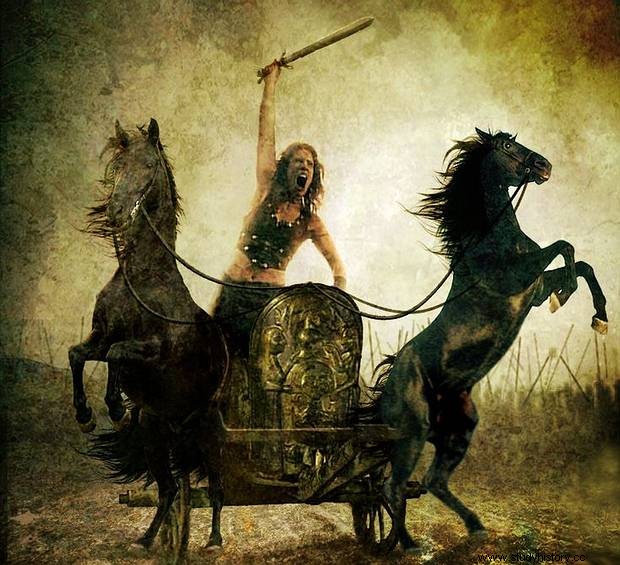Boudica , also known as Boadicea in Latin sources, she was the queen of the Iceni, a British tribe that inhabited what is now the county of Nortfolk, in eastern England. Coming from the indigenous nobility, her husband was Prasutagus, King of the Eceni . Both Cassius Dio and Tacitus agree on the physical and emotional description of this extraordinary woman. According to the latter " she had a greater intelligence than women generally have ”. She seems to have been a stocky woman, much higher than the average Roman height, with a hard voice and an alienated look. She was dressed in multi-colored robes girdled by a cloak and her red hair hung down to her hips. On her neck stood out a thick gold torque, a Celtic symbol of the power of the indigenous oligarchy.

Boudica
The land of the Eceni had not suffered the horrors of war during the conquest of Britain in 43 AD. This tribe was an ally of the Romans and therefore was left out of the reprisals and destruction caused by said invasion in the time of Emperor Claudius. But the Roman occupation ended up stirring up the British independentist pretensions, well seen and fed by the toughest faction of the Eceni nobility. Several neighboring fractious tribes rose up against the Roman authority, which acted forcefully. The veiled support of the Iceni for these tribes did not go unnoticed by the governor Publius Ostorio Escápula , which even threatened them with total disarmament.
Prasutagus, the Eceni king, was a good vassal of Rome. His reign was long and calm, although an important detail would condition the future of his people:he had no sons, only daughters. This thorny succession issue was not a problem for the indigenous society, which would accept it willingly, but it did conflict with the clientele agreements signed with Rome. Prasutagus's great mistake was to appoint the emperor as co-heir of his daughters, a common practice in those times. With this he hoped to maintain in his succession the balance of power that he had achieved in his territory. But the Lex Romana did not contemplate it that way, the only possible inheritance that he accepted was from fathers to sons.
When the king died, the territory remained in the hands of the governor of Britannia, who ignored the previous agreements and acted in the area as had been customary in the rest of the provinces of the Empire. As if it were conquered land, much land was expropriated, much property confiscated, and the arrogant Eceni nobility were treated as if they were uncivilized barbarians. The situation worsened when Boudica, the king's widow, was unable to repay the loans her husband had acquired from Rome. According to Cassius Dio, the publicans unleashed a savage plundering operation to collect the debt, looting villages and enslaving many Eceni who could not afford the excessive imperial taxes. Tacitus highlighted within these events the terrible behavior of the attorney Deciano, apparently the instigator of a bloody collection action that ended with Boudica herself whipped and her two daughters raped by her. The queen never forgave such an outrage and began plotting a full-scale revolt against the power of Rome.
The opportunity came in the year 61. At that time, a certain Caius Suetonius Paulinus was governor of Britain. . Fresh from Mauritania, he set out for the island of Mona (now Anglesey) to root out resistance from the last druidic stronghold. Boudica took advantage of the governor's absence from British soil to conspire with her nobles and unleash the rebellion. Soon the revolt spread to the trinovantes neighbors of her (the present county of Essex)
Boudica's first objective was Camulodunum (today Colchester), the main city of the Trinovante territory and at that time a Roman colony. The city garrison asked for help in holding back the rebel horde. But the procurator Deciano sent a sad support force of two hundred auxiliaries that was unable to stop the insurgents. The city was destroyed and burned, including the temple to the imperial cult in which its last defenders took refuge. All of them without exception were put to the knife, men women and children.
The only one who tried to rescue the Camulodunum garrison was Fifth Petillo Cerial , legate of the Legio IX Hispana and future governor of Britannia. He was caught in an ambush in a forest near the city and, after a fierce fight, he had to abandon his purpose, losing many men in the attempt. The one who fled miserably was the miser Decian Cato , who seeing the turn that events were taking and knowing that he was guilty of that revolt due to his inexhaustible greed, chose to leave Britannia and hide in Gaul Belgium.
The capture of Camulodunum and the subsequent victory against the troops of Petilius Cerial they gave strength to the insurgents, who continued their overwhelming advance towards Londinium (London). Gaius Suetonius, now free from the campaign he had undertaken in Wales, directed his troops there as soon as he learned of Boudica's intentions, but faced with the apparent impossibility of being able to defend it properly, he chose to withdraw to a more optimal place to fight and abandon it to your luck. Again, the city was razed and its inhabitants massacred. And it was not the last, Verulamium (St. Alban) suffered the same fate…
Gaius Suetonius was the one who chose the place where he would face the insurgents. This decisive battle took place in an undetermined place between Londinium and Viroconium (Wroxeter) A priori, the Roman forces had everything to lose. The insurgents outnumbered them 5 to 1, but Suetonius chose the scene of battle well. It was a plain that stretched out in front of a narrow wooded gorge that did not allow the enemy to encircle their lines. This topographic condition averted the indigenous numerical advantage. In addition, the Roman troops were very well trained and equipped, while the indigenous mass, made up of levies of children, men and the elderly, was much more difficult to lead and mobilize.
The morning of the fight Suetonius got up at dawn, warned by his tribunes that the rebel army had formed up in front of them. A vague line formed in a crescent unfolded before him, closed behind by the Britons' own chariots that served as shelter for expectant women and children before a presumed great victory. Suetonius, well trained in the warlike deeds of Mario and César, saw in that the way to turn a British feast into a real hell. He formed his men with the classic double line in the form of saw teeth.
According to Tacitus , who narrated these events fifty years after they occurred, Boudica released this harangue to his troops:
Nothing is safe from Roman arrogance and pride. They will disfigure the sacred and deflower our virgins. Win the battle or perish, such is my decision as a woman:there the men if they want to live and be slaves
Suetonius did the same with his:
Ignore the cries of these savages. There are more women than men in their ranks. They are not soldiers and are not properly equipped. We've beaten them before, and when they see our iron and feel our courage, they'll give in on the spot. Stand shoulder to shoulder. Throw the spears, then move forward:take them down with your shields and finish them off with your swords. Forget the loot. Just win and you will have it all
That was how it happened. Suetonius he lined up the troops and awaited developments. The Britons, impatient and unaware of the Roman tricks, after hours of observing the enemy's perfectly motionless formation, charged the front line. The gorge shortened the magnitude of the noisy British charge, which crashed into a hail of spears from the Roman front line. The pila (plural of pilum) were a devastating weapon. Once nailed, they left the shields useless, or pierced the unarmored bodies of the natives like a pin through butter. After the second hail of spears, a tapestry of corpses and the dying stretched out in front of the gorge. It was time to move on. Steadfast, gladius in hand, the Roman troops overwhelmed the Britons, slashing at them from their secure shield wall and driving them toward their chariots with cavalry charges from the flanks. It is assumed that more than forty thousand Britons were trampled to death after the disbandment of the insurgent army upon seeing the implacable advance of the legions and close to eighty thousand at the end of that bloody day in which nothing was respected. The British impedimenta itself acted as a dam and congested the flight. The legions massacred the indigenous masses, men, women and children, in one of the bloodiest episodes in the entire history of Roman Britain. It may have been propaganda, but classical historians attribute only four hundred casualties to Roman troops compared to thousands of fallen Britons. It is likely knowing other battles similar to this one, such as the one between Lucullus and Tigranes, where Rome only lost thirty men and Armenia twenty thousand.

According to Tacitus, Boudica he was poisoned before falling into Roman hands, although according to Dio Cassius he was able to survive that disaster, although he fell ill and died some time later. Boudica's revolt marks the last great indigenous attempt to free themselves from the Roman yoke. Except for two little-documented riots and some Pictish riots, the island would remain peaceful until the arrival of the Angles and Saxons in the 5th century.
Collaboration of Gabriel Castelló , author of “Archienemies de Roma”
Illustration:Aitor López García
